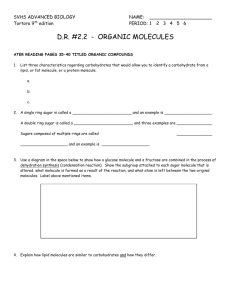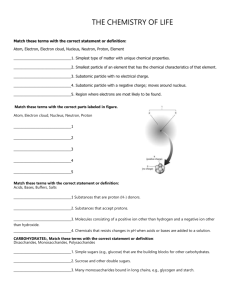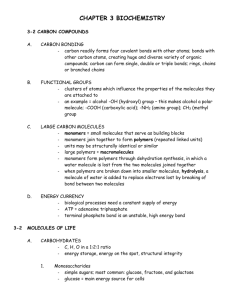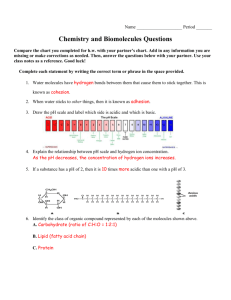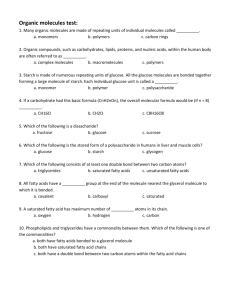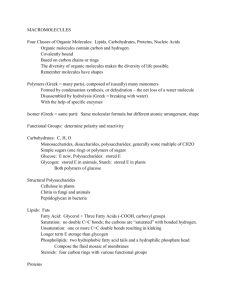Chapter 3
advertisement
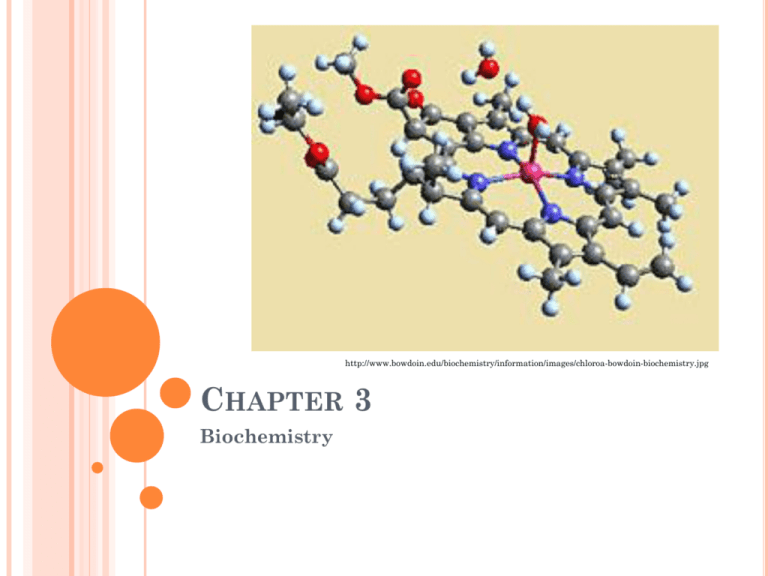
http://www.bowdoin.edu/biochemistry/information/images/chloroa-bowdoin-biochemistry.jpg CHAPTER 3 Biochemistry SECTION 1 PRETEST Organic Compound Functional Group Monomer Polymer Macromolecule Condensation Reaction Hydrolysis ATP A. A simple molecule that combines with other molecules to make a larger molecule B. The main energy molecule for organic processes. C. Reaction when two molecules combine to produce water. D. The portion of a molecule that is active in a chemical reaction E. Carbon containing compound F. A large molecule formed when smaller units combine G. Chemical reaction involving water and another substance to produce something new H. Very large molecules formed from hundreds or thousands of atoms ANSWER KEY Organic Compound Functional Group Monomer Polymer Macromolecule Condensation Reaction Hydrolysis ATP E D A F H C G B THE ELEMENT OF LIFE: CARBON Carbon is regarded as the element of life Organic Compounds —contain carbon (and hydrogen) Carbon can form the large, complex molecules common to all living things because of its structure. Carbon has 4 electrons in its outer shell. The shell can hold 8. Carbon needs 4 more electrons to become stable, creating up to four covalent bonds. http://www.chemistrydaily.com/chemistry/upload/d/d9/Covalent.png Carbon also has a tendency to bond with itself. This can result in big biological molecules based around chains or rings of carbon atoms. http://www.succeed.ufl.edu/content/abe2062/lect/lect_02/3_01.gif Many complex biological molecules will be formed using double and triple covalent bonds. Double —share 2 pair of electrons Triple —share 3 pair of electrons Each line represents a covalent bond. Carbon must have four covalent bonds—or four lines FUNCTIONAL GROUPS Functional group —the portion of a molecule that is active in a chemical reaction and that determines the properties of many organic compounds. Example Hydroxyl OH Makes molecules polar, this means they are hydrophilic (soluble in water) Called alcohols Functional Group Hydroxyl (Alcohols) Carbonyl (on end) (Aldehydes) Carbonyl (in middle) (Ketone) Carboxyl (Organic Acids) Amino (Amino Acids) Phosphate (Nucleic Acids) Structural Formula -OH H - C=O O C COOH NH2 PO42- Example LARGE CARBON MOLECULES The building of large molecules occurs as follows: Monomers —small, simple carbon molecules Polymers —consists of repeated, linked monomers Macromolecules —large polymers: (Carbohydrates, lipids, proteins, nucleic acids) http://kenpitts.net/bio/human_anat/monomer.jpg CONDENSATION REACTIONS Polymers form during condensation reactions In these reactions; water is released Example: Glucose and Fructose combine to form Sucrose HYDROLYSIS Polymers break down by a hydrolysis reaction In these reactions; water is used http://imcurious.wikispaces.com/file/view/hydrolysis_reaction.jpg/113609729/hydrolysis_reaction.jpg THE ENERGY MOLECULE: ATP Adenosine triphosphate (ATP) —a molecule that stores a large amount of energy in its overall structure. This is a major source of energy for most living cells Named the “energy currency” for living cells because it is nearly a “universal molecule of energy transfer” in living things Energy can be stored as carbohydrates or lipids, but that energy (in chemical bonds) must be transferred to ATP before it can be used in the cell STRUCTURE OF ATP ATP is made of “Adenine” and “Ribose” and three phosphate groups Adenine = nitrogen containing compound Ribose = 5-carbon sugar Phosphate groups = PO4 http://www.bio.miami.edu/~cmallery/150/metab/sf6x1a.jpg The Hydrolysis of ATP is used by the cell to provide the energy needed to drive chemical reactions. It happens according to the following diagram: http://kentsimmons.uwinnipeg.ca/cm1504/atp.htm -ATP can lose its end phosphate which releases the energy stored in it and makes adenosine diphosphate (ADP). -This energy is used to do work in the cell. -Adding the phosphate back to make ATP requires that we add energy SECTION 2 PRETEST Carbohydrate Monosaccharide Disaccharide Polysaccharide Protein Amino acid Peptide bond Enzyme Substrate A. Organic compound made of amino acids B. Organic compound made of carbon, hydrogen and oxygen C. Proteins that speed up chemical reactions. D. Simple sugar E. Double sugar F. Buiding blocks of proteins G. Holds amino acids together when forming proteins H. Sugar formed from three or more monosaccharides I. The reactant in a chemical equation that is acted upon by enzymes Active site Lipid Fatty acid Phospholipid Wax Steroid Nucleic Acid DNA RNA Nucleotide J. Unbranched carbon chains that make up lipids K. Type of lipid forming protective layers on plants and animals L. Type of lipid found in many hormones M. Deoxyribonucleic acid N. Folds found in enzymes that fit into a specific substrate O. Ribonucleic acid P. Large organic compounds that do not dissolve in water Q. Type of lipid found in the cell membranes of living things. R. Large organic compounds that store and transfer information in cells S. Part of a DNA molecule ANSWER KEY Carbohydrate Monosaccharide Disaccharide Polysaccharide Protein Amino acid Peptide bond Enzyme Substrate B D E H A F G C I Active site Lipid Fatty acid Phospholipid Wax Steroid Nucleic Acid DNA RNA Nucleotide N P J Q K L R M O S THE MOLECULES OF LIFE Four main groups of organic compounds: Carbohydrates Proteins Lipids Nucleic Acid http://ez002.k12.sd.us/Chapter%20One%20Science.htm CARBOHYDRATES Composed of carbon, hydrogen and oxygen Make up about 1% of a cell Used for energy and structural materials Three types: Monosaccharides —simple sugar Disaccharides —double sugar Polysaccharides —three or more monosaccharides Monosaccharides —Contain C,H and O in a ratio of 1:2:1 (CH2O)n Note: N = whole # from 3-8 Examples Glucose (energy for cells) Fructose (fruit sugar) Galactose (milk sugar) Note: All three have the same molecular formula C6H12O6 just different structures therefore they are called isomers Disaccharides —two monosaccharides combine in a condensation reaction. Example: Sucrose (table sugar) Formed when glucose and fructose combine Sucrose Example: Glucose and Fructose combine to form Sucrose Polysaccharide —three or more monosaccharides form a much more complex molecule. Examples: Glycogen —hundreds of glucose molecules joined in a large branching chain. Stored in the liver and muscles of most animals and is used for quick energy Starch —glucose molecules joined together and stored in plants for energy. Cellulose —thousands of glucose molecules joined together in a straight chain. Provides the structure for plant cell walls PROTEINS Composed of C, H, O and N Make up about 15% of a cell Found in hair, horns, skin, muscles, and enzymes Chains of amino acids (building blocks of proteins) 20 different amino acids with similar structures Only their R group varies The R groups determine their different shapes and functions Carboxyl Group http://cornellbiochem.wikispaces.com/23.2 Dipeptide —two amino acids joined by a peptide bond. Peptide bonds are formed by condensation reactions in which water is released Polypeptide —long chains of amino acids. They fold and bend themselves into large protein molecules. Temperature and solvent type can influence the shape of proteins. Ex: egg whites Enzymes —special types of proteins that act as catalysts http://intranet.broadfordsc.vic.edu.au/yr12biol/enzymes_as_biological_catalysts_files/image003.gif The enzyme can attach only to a substrate (reactant) with a specific shape. The enzyme changes and reduces the activation energy of the reaction so reactants can become products. The enzyme is unchanged and is available to be used again. LIPIDS Composed of C, H and O —but in a higher ratio of carbon and hydrogen atoms to oxygen atoms than carbohydrates have: therefore, they store more energy Make up about 10% of a cell Used to store extra energy and in cell membranes Nonpolar —do not dissolve in water Most are made of fatty acids bonded to other molecules Examples: triglycerides, phospholipids, steroids, waxes, and pigments FATTY ACIDS To fully understand how lipids work, we need to first understand their fatty acid component Fatty acids —long, unbranched carbon chains with a carboxyl group on one end. Carboxyl end = polar and reacts with water (hydrophilic “water loving”) Hydro-carbon end = nonpolar and does not react with water (hydrophobic “water fearing”) http://library.med.utah.edu/NetBiochem/mml/fa_polypatt01.gif Saturated Fatty Acids —each carbon is covalently bonded to four atoms (NO DOUBLE BONDS) Unsaturated Fatty Acids —not all carbons are bonded to four other atoms (HAS DOUBLE BONDS) http://www.biology.lsu.edu/introbio/Link2/fatty%20acids.gif CLASSES OF LIPIDS Triglycerides (fats) —three molecules of fatty acid joined to one molecule of glycerol. Saturated triglycerides —the 3 fatty acids are saturated: hard at room temp: found in butter and red meat: “bad fats” Unsaturated triglycerides —the 3 fatty acids are unsaturated: soft at room temp: found in plant seeds: “good fats” Phospholipids —two fatty acids joined to glycerol. They also have a phosphate group. Important part of all cell membranes Waxes —fatty acid chain joined to an alcohol chain: waterproof: form protective layers in plants and animals Steroids —four fused carbon rings with a functional group: include many hormones and cholesterol NUCLEIC ACIDS Composed of C, H, O, N, and P Make up 4% of a cell Consists of repeating monomers called nucleotides Each nucleotide has a phosphate group, a 5-carbon sugar and a nitrogen base Important in the transfer of information in the cell Types: DNA —Deoxyribonucleic acid: determines the characteristics of an organism and directs cell activities RNA —Ribonucleic acid: transfers information from DNA to ribosomes: helps manufacture proteins: can act as enzymes Nucleotide DNA Strand
